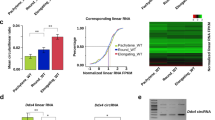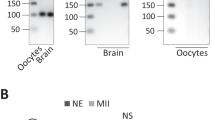Abstract
WE have shown that, when injected into Xenopus oocytes, poly (A) free globin messenger RNA is translated for a short period of time and then rapidly degraded1–3, while, under the same conditions, native mRNA shows a marked stability1,2,4. The poly (A) segment itself is responsible for the stability of native globin mRNA, since its readdition to previously de-adenylated mRNA restores the stability of the message5. We have shown also that the poly (A) stretch must contain a minimum number of adenylate residues to ensure its protective function6. It was interesting to see whether the concept of the stabilisation of eukaryotic mRNAs by 3′-OH polyadenylation is general. This can be done by looking at the effect of the presence of a 3′-OH poly (A) segment on the stability of various mRNAs. Here we study the stability of HeLa cell poly (A)-free histone mRNAs injected into Xenopus oocytes, and the effect of 3′-OH polyadenylation on this stability.
This is a preview of subscription content, access via your institution
Access options
Subscribe to this journal
Receive 51 print issues and online access
$199.00 per year
only $3.90 per issue
Buy this article
- Purchase on Springer Link
- Instant access to full article PDF
Prices may be subject to local taxes which are calculated during checkout
Similar content being viewed by others
References
Huez, G. et al. Proc. natn. Acad. Sci. U.S.A. 71, 3143–3146 (1974).
Marbaix, G. et al. Proc. natn. Acad. Sci. U.S.A. 72, 3065–3067 (1975).
Huez, G. et al. Nature 266, 473–474 (1977).
Gurdon, J. B., Lingrel, J. B. & Marbaix, G. J. molec. Biol. 80, 539–551 (1973).
Huez, G. et al. Eur. J. Biochem. 59, 589–592 (1975).
Nudel, U. et al. Eur. J. Biochem. 64, 115–121 (1976).
Breindl, M. & Gallwitz, D. Eur. J. Biochem. 32, 381–391 (1973).
Gallwitz, D. Nature 257, 247–248 (1975).
Gurdon, J. B., Lane, C. D., Woodland, H. R. & Marbaix, G. Nature 233, 177–182 (1971).
Laemmli, U. K. Nature 227, 680–685 (1970).
Laskey, K. A. & Mills, A. D. Eur. J. Biochem. 56, 335–341 (1975).
Sippel, A. Eur. J. Biochem. 37, 31–40 (1973).
Hieter, P. A., LeGendre, S. M. & Levy, C. G. J. biol. Chem. 215, 3287–3293 (1976).
Marbaix, G., Huez, G. & Soreq, H. Trends Biochem. Sci. 2, N106–N107 (1977).
Author information
Authors and Affiliations
Rights and permissions
About this article
Cite this article
HUEZ, G., MARBAIX, G., HUBERT, E. et al. Functional stabilisation of HeLa cell histone messenger RNAs injected into Xenopus oocytes by 3′- OH polyadenylation. Nature 271, 572–573 (1978). https://doi.org/10.1038/271572a0
Received:
Accepted:
Published:
Issue Date:
DOI: https://doi.org/10.1038/271572a0
This article is cited by
-
Male sterility in Heliothis virescens x H. subflexa backcross hybrids
Molecular and General Genetics MGG (1986)
-
The translational control phase of early development
Bioscience Reports (1982)
-
Poly(A) polymerase and poly(A)-specific mRNA binding protein are antigenically related
Nature (1979)
Comments
By submitting a comment you agree to abide by our Terms and Community Guidelines. If you find something abusive or that does not comply with our terms or guidelines please flag it as inappropriate.



